In the third quarter of 2025, the U.S. economy showed continued resilience despite mounting challenges. Preliminary estimates suggest that Real Gross Domestic Product (GDP) grew at an annualized rate of 1.9%, down from 3.8% in the second quarter, but still indicative of moderate strength. This slowdown reflects the impact of trade tensions, fiscal uncertainty (including looming Federal government shutdown), and geopolitical conflicts (Israel/Hamas and Ukraine/Russia). Despite these headwinds, recession risks remain low, and the economy continued to expand.
Labor market conditions softened in the third quarter. While September economic data are not available due to the Federal government shutdown, estimates are that the U.S. economy added just 50,000 jobs (nonfarm payrolls) in September and the unemployment rate held steady at 4.3%, indicating a relatively lackluster labor market. Average hourly earnings are estimated to have continued to rise, supporting consumer spending, while average hours worked are likely to remain unchanged. Against this backdrop, consumer confidence continued its decline in the third quarter.
The Federal Reserve maintained its deliberate stance during the third quarter of 2025. At its September meeting, the Fed cut interest rates by 0.25%, lowering the target range to 4.00%–4.25%. This move was in response to weakening labor market data, while inflation, which is forecast to have risen by 3.1% year-over-year in September, appears stable. Given the soft labor market and indications that inflation is not at risk of rising significantly, a further 25 basis point cut is also expected at the Fed’s October meeting. Beyond that, unless inflation shows signs of trending lower towards the Fed’s 2% target rate, it is unlikely that Fed Funds have much more downside potential.
Political uncertainty continued to weigh on business sentiment. The administration’s tariff policies and proposed federal employment cuts create economic uncertainty for many. The national debt surpassed $37.8 trillion, exceeding $109,000 per citizen, and interest payments reached record levels. Significant political partisanship on issues such as the government shutdown bodes poorly for addressing the looming national debt crisis.
Globally, the economic landscape in Q3 2025 was mixed. Developed economies such as the EU and Japan experienced slower growth compared to the U.S., with EU GDP growth projected at 1.3% and Japan at 1.1%. Emerging markets showed divergence: China rallied on tech exports and fiscal support, while India underperformed due to foreign outflows and valuation concerns. A substantially weaker U.S. dollar was mirrored by appreciating foreign currencies and benefiting international investments, but inflation and trade disruptions remained key challenges for the global economy.
Geopolitical tensions persisted, particularly in the Middle East and Eastern Europe. These conflicts continued to impact energy prices and supply chains, contributing to inflationary pressures. Meanwhile, technological innovation, especially in AI, drove investment and productivity gains across sectors. Despite volatility, global sentiment remained cautiously optimistic.
Looking ahead, the U.S. economy faces heightened uncertainty. The government shutdown, as well as the escalation of trade disputes and immigration policy changes, could dampen growth, with risks of GDP contraction in the coming quarters. Inflationary pressures may intensify, complicating the Fed’s policy decisions. Investors should prepare for increased volatility and policy-driven market shifts.
Globally, the outlook remains fragile. Developed economies are expected to grow modestly, while emerging markets may face headwinds from tariffs and geopolitical instability. Central banks are likely to maintain accommodative stances, but fiscal constraints and inflation risks could limit flexibility.
In light of these conditions, investors should remain focused on long-term objectives. Diversification across asset classes, sectors, and geographies is key to managing risk and capturing opportunities. Staying informed and disciplined will be essential in navigating the evolving economic landscape.
Sources:
• Bureau of Economic Analysis
• Bureau of Labor Statistics
• International Monetary Fund
• The Conference Board
Certain statements may include forward-looking information based on current beliefs, expectations, and assumptions. These statements are not guarantees of future performance and involve known and unknown risks, uncertainties, and other factors that may cause actual results to differ materially. Inspire undertakes no obligation to update or revise any forward-looking statements.

The third quarter started out with a continuation of the rally from last quarter across U.S. and global markets and maintained that momentum until late September, when the markets started to show weakness. The international markets failed to outperform the U.S. markets as they did in the first two quarters of the year, as investors’ optimism shifted to small and mid-cap stocks. The S&P 600 Small Cap index, the S&P 400 Mid Cap Index, and the S&P 500 Index all ended the quarter with good returns of 9.11%, 5.55% and 8.11% respectively, while the S&P International 700 index posted a competitive return of 7.03%.
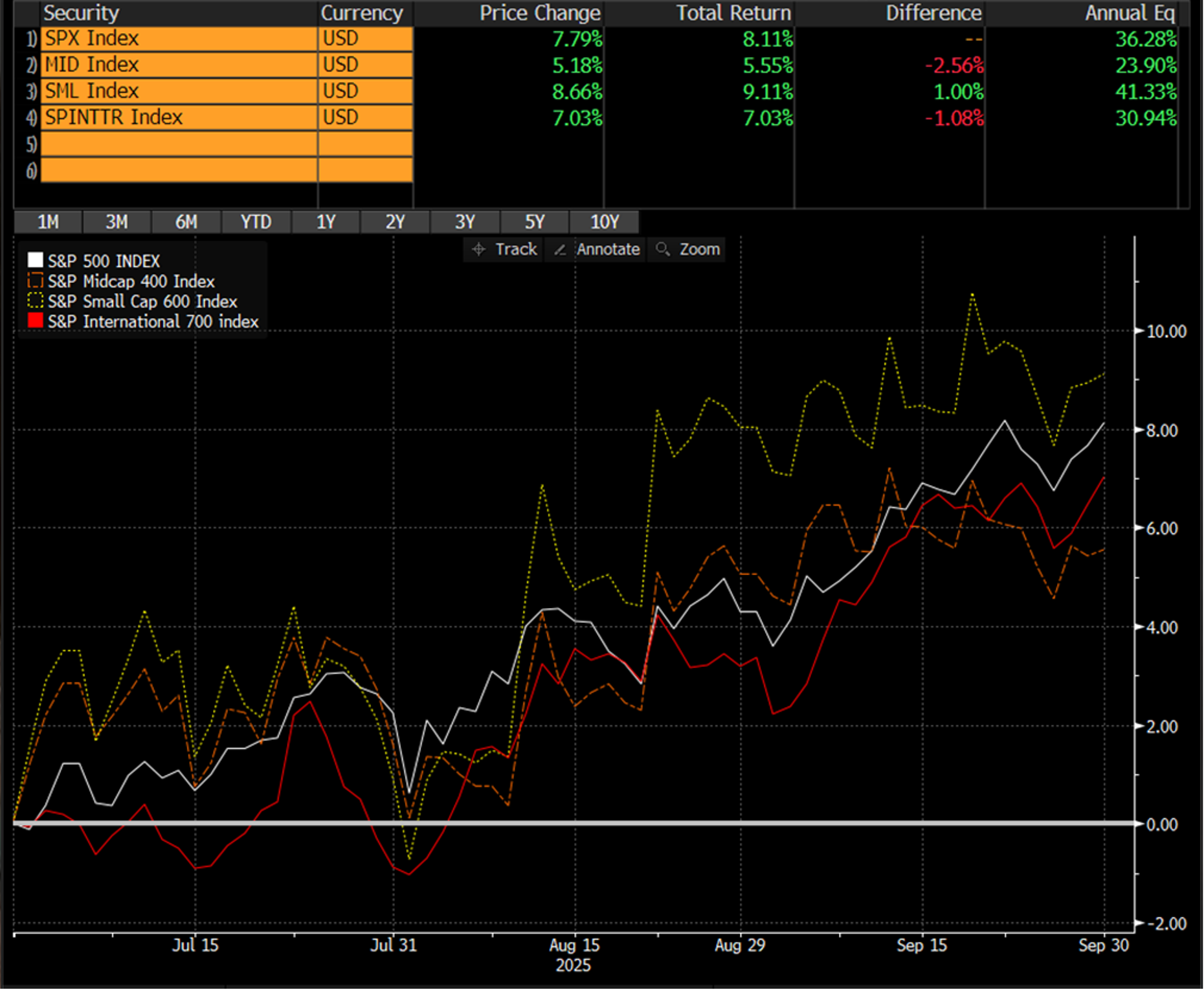
Over the past 12 months, the stock market witnessed a generally positive trajectory across all the major equity indexes until mid-February, when the U.S. markets started to fall toward correction territory. The S&P 500 still experienced strong growth during this period, turning in a one-year number of 17.56% on a total return basis. In contrast, the S&P 400 and S&P 600, representing mid-cap and small-cap companies, enjoyed overall gains until February 19th when the retreat started. After hitting support in early April, all major markets rallied through the end of the third quarter. The S&P 400 Mid-Cap Index posted a one-year return of 6.10%, outpacing the S&P 600 Small Cap Index that rose only 3.61% during the same time frame. As for the S&P International 700 Index, it has had strong momentum since April and outpaced the S&P 500 Index with a one-year return of 18.81% vs the U.S. Large Cap Index, which went up 17.56%. Overall, the past 12 months exhibited positive market sentiment even in the face of continued headwinds of inflation numbers not falling as fast as the markets had previously hoped. Even though we are in the first innings of the new bull market, we could easily see a correction before the end of the year or in early 2026. Even with this warning in mind, we recommend investors remain invested and stay focused on the long-term opportunities in a well-diversified global portfolio, as the probability of positive returns over the next 12 to 24 months once this correction is over is extremely high.
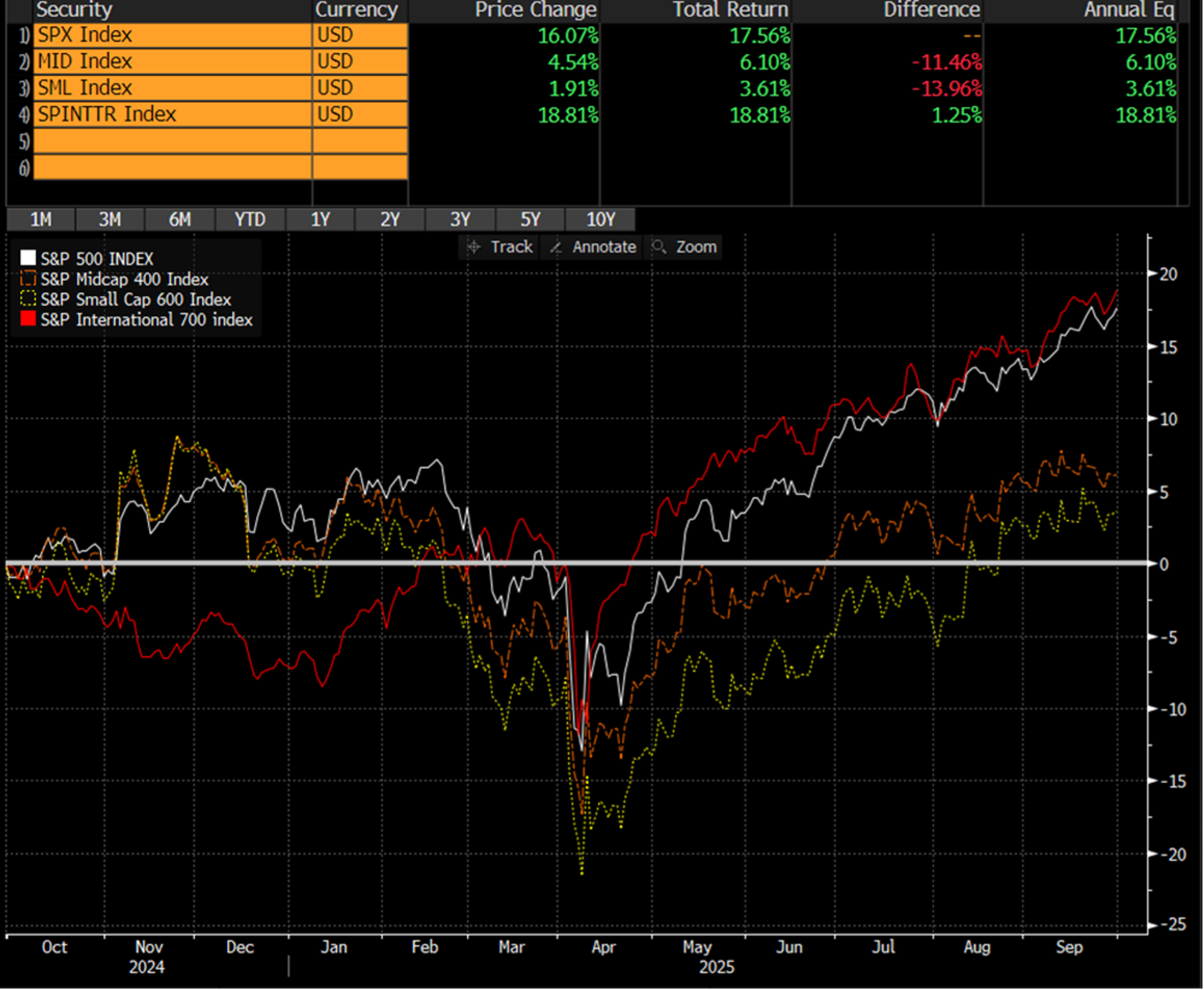
Inflation came in at 0.20% (month-over-month) in July, meeting expectations of a 0.20% increase. The estimate for the month-over-month number in August was for an increase of 0.30% but came in higher than expected at 0.40%. The forecast is for September for a month-over-month increase of 0.40% but will not be released until October 24th. We will likely continue to see month-over-month numbers stay in the 0.20% to 0.40% territory for the next several months, which will keep the CPI year-over-year number close to the 3% level over the next 12 months, especially if money supply growth continues its rebound and ongoing tariff wars move prices higher.
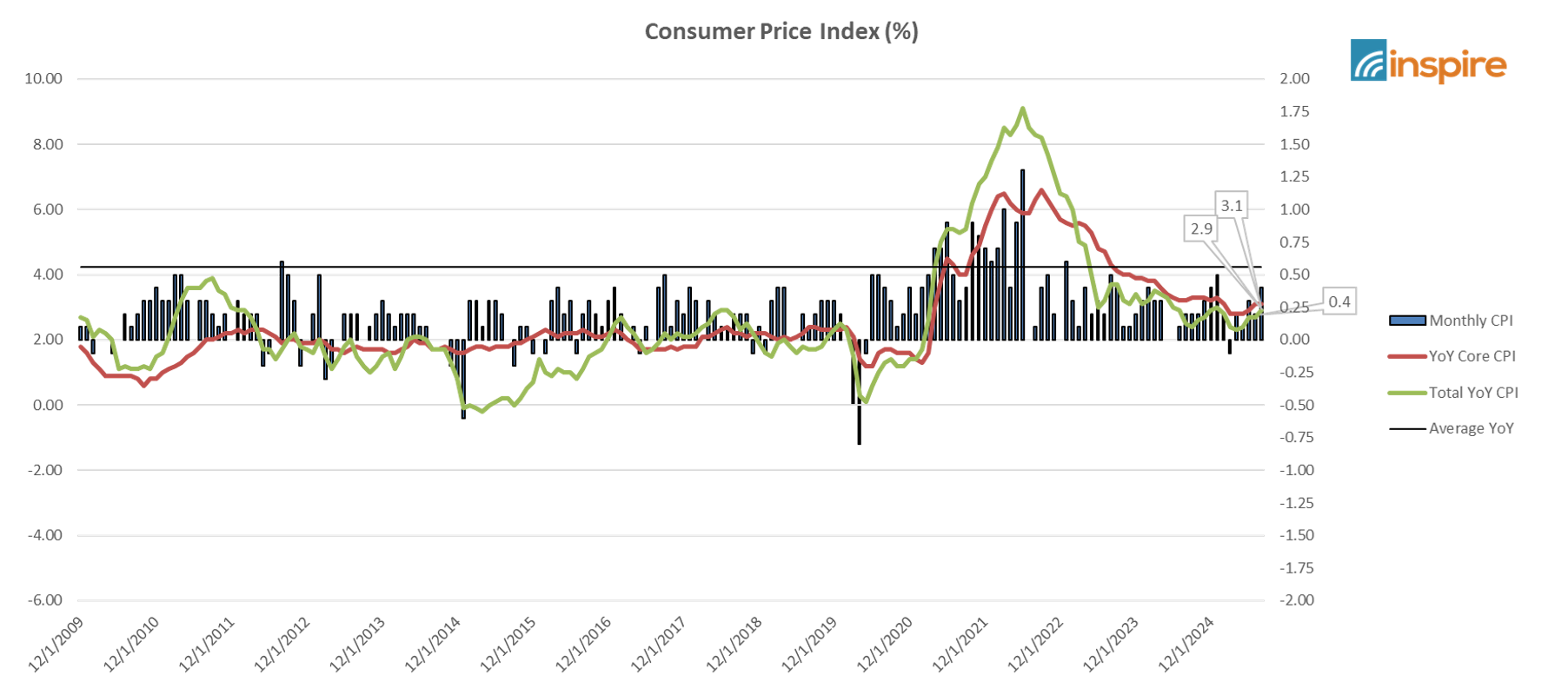
GDP growth came in higher than the initial expectation of 2.6% for the second quarter, with an actual 3.0% growth rate for the quarter in the Advance Release. The expectation was revised to 3.1% for the Second Release and beat that expectation at 3.3%. The Third revision raised the expectation to 3.3% but the actual print came in much stronger than expected when it was released at 3.8%. The debate among economists and market pundits during the past quarter has been focused on how quickly the Fed will lower interest rates during the remainder of 2025.
The yield curve is no longer inverted, but there is now a fear of a recession brought on by a slowing labor market, slower consumer spending, and uncertainty over the Trump administration’s policies and their effect on the U.S. consumer. Recessions are usually declared after an inversion corrects, so this would not be surprising.
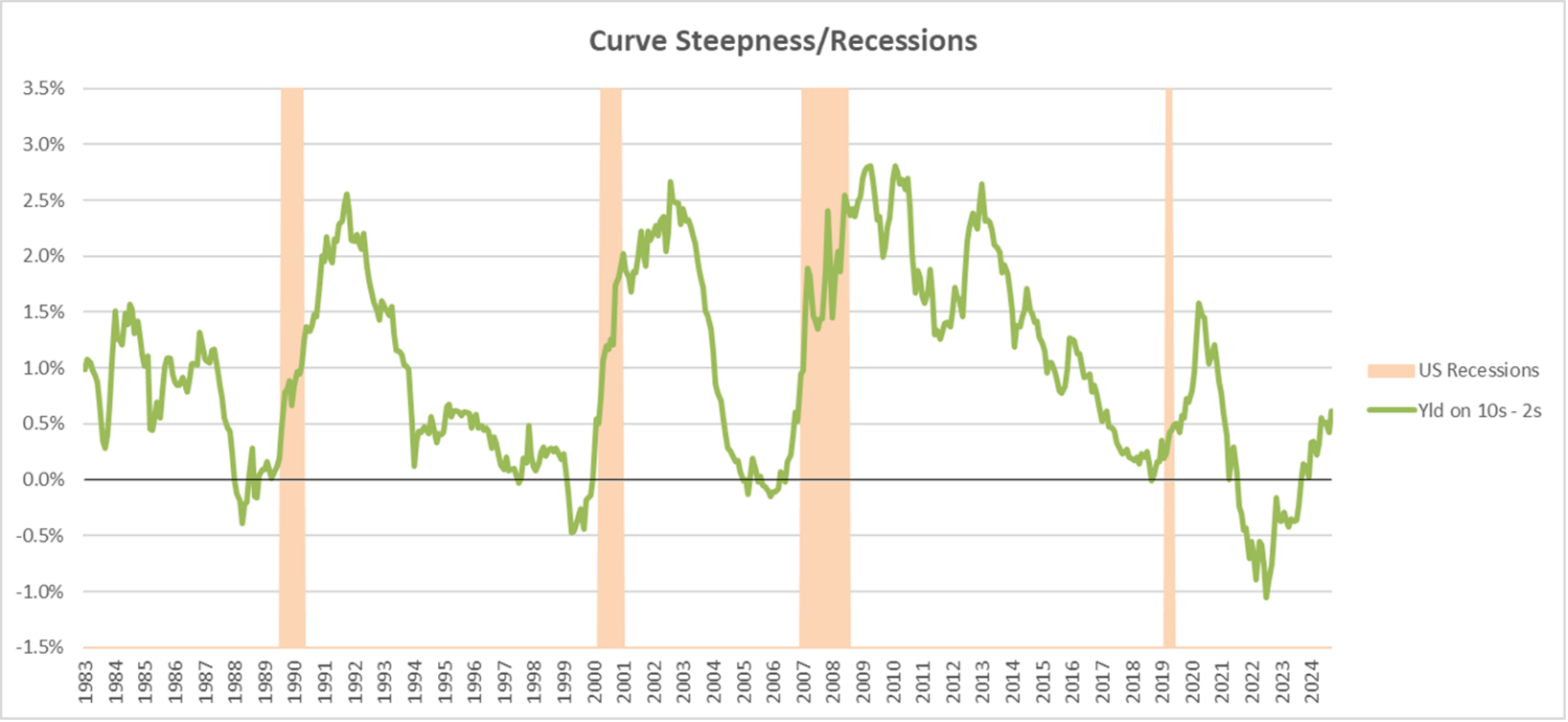
The Unemployment Rate rose to 4.2% in July and to 4.3% in August before falling back to 4.1% in September. It was expected that the Unemployment Rate would rise to 4.3% in July due to the increase in layoffs in the government workforce and a slowing job market. Although we are still above the 4% level, it is possible we could see the Unemployment Rate return to its upward path for the final three months of 2025 if the economy slows and layoffs increase if the government shutdown that started as the third quarter came to an end drags on for several weeks.
Nonfarm Payrolls had a weak showing with July coming in at only 73k new jobs, which was below the estimate of 107k. The new job numbers weakened in August by coming in at 22k jobs vs the expectation of 76k. The job numbers remained weak for September, with only 22k new jobs again, which was much weaker than the expected 50k job growth. The job market has been showing signs of slowing over the past few months, but it is still possible that a recession may be averted.
The Federal Open Market Committee finally returned to the path of cutting the Federal Funds rates during the meeting on September 17th by cutting the benchmark range by 25 bps. Based on Chair Powell’s recent comments, we should not be surprised if the speed of rate cuts coming from the FOMC remains slow for the next several months and will be dependent on the data, which shows a slow but resilient economy. Although many analysts fully expect the rate cut cycle to continue in the final two meetings in 2025, a few economists are saying there will be no more interest rate cuts in 2025 if inflation starts to rise. The current expectation is for the terminal rate to be in the 3.25% range by mid-2027 due to ongoing inflationary concerns. The Federal Reserve has faced a challenging balancing act throughout 2025. While a cooling labor market would typically justify rate cuts, concerns about inflation driven by rising tariffs have kept the Fed on pause. Instead of easing policy, the Fed has been extremely slow in its moves, waiting for clearer data on both inflation and broader economic conditions.
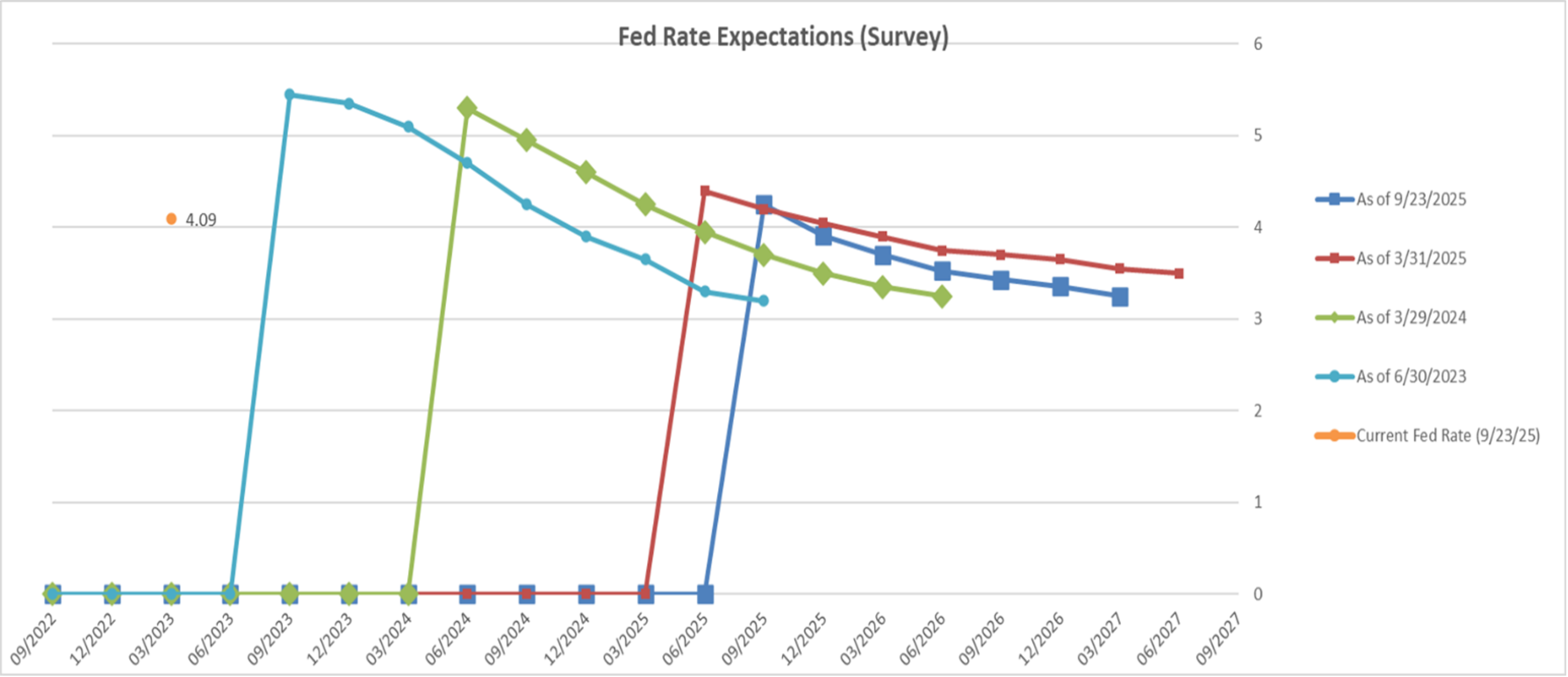
Inspire Investing, LLC serves as the investment adviser to certain proprietary ETFs used in Inspire portfolios. Inspire receives management fees from these ETFs, creating a potential conflict of interest. Inspire seeks to mitigate this conflict through policies and procedures that ensure recommendations are made in clients' best interests and consistent with their unique goals and risk profiles. Additional details can be found in Inspire's Form ADV Part 2A. Past performance is not indicative of future results. All performance figures referenced herein are historical and may not reflect current or future market conditions. Actual investor outcomes may vary. There is no assurance that any investment strategy will achieve its objectives or avoid losses.
Inspire Investing, LLC serves as the investment adviser to certain proprietary ETFs used in Inspire portfolios. Inspire receives management fees from these ETFs, creating a potential conflict of interest. Inspire seeks to mitigate this conflict through policies and procedures that ensure recommendations are made in clients' best interests and consistent with their unique goals and risk profiles. Additional details can be found in Inspire's Form ADV Part 2A. Past performance is not indicative of future results. All performance figures referenced herein are historical and may not reflect current or future market conditions. Actual investor outcomes may vary. There is no assurance that any investment strategy will achieve its objectives or avoid losses.
Inspire Investing, LLC serves as the investment adviser to certain proprietary ETFs used in Inspire portfolios. Inspire receives management fees from these ETFs, creating a potential conflict of interest. Inspire seeks to mitigate this conflict through policies and procedures that ensure recommendations are made in clients' best interests and consistent with their unique goals and risk profiles. Additional details can be found in Inspire's Form ADV Part 2A. Past performance is not indicative of future results. All performance figures referenced herein are historical and may not reflect current or future market conditions. Actual investor outcomes may vary. There is no assurance that any investment strategy will achieve its objectives or avoid losses.
Inspire Investing, LLC serves as the investment adviser to certain proprietary ETFs used in Inspire portfolios. Inspire receives management fees from these ETFs, creating a potential conflict of interest. Inspire seeks to mitigate this conflict through policies and procedures that ensure recommendations are made in clients' best interests and consistent with their unique goals and risk profiles. Additional details can be found in Inspire's Form ADV Part 2A. Past performance is not indicative of future results. All performance figures referenced herein are historical and may not reflect current or future market conditions. Actual investor outcomes may vary. There is no assurance that any investment strategy will achieve its objectives or avoid losses.
Inspire Investing, LLC serves as the investment adviser to certain proprietary ETFs used in Inspire portfolios. Inspire receives management fees from these ETFs, creating a potential conflict of interest. Inspire seeks to mitigate this conflict through policies and procedures that ensure recommendations are made in clients' best interests and consistent with their unique goals and risk profiles. Additional details can be found in Inspire's Form ADV Part 2A. Past performance is not indicative of future results. All performance figures referenced herein are historical and may not reflect current or future market conditions. Actual investor outcomes may vary. There is no assurance that any investment strategy will achieve its objectives or avoid losses.
Inspire Investing, LLC serves as the investment adviser to certain proprietary ETFs used in Inspire portfolios. Inspire receives management fees from these ETFs, creating a potential conflict of interest. Inspire seeks to mitigate this conflict through policies and procedures that ensure recommendations are made in clients' best interests and consistent with their unique goals and risk profiles. Additional details can be found in Inspire's Form ADV Part 2A. Past performance is not indicative of future results. All performance figures referenced herein are historical and may not reflect current or future market conditions. Actual investor outcomes may vary. There is no assurance that any investment strategy will achieve its objectives or avoid losses.
The Inspire Tactical Balanced ETF (NYSE: RISN) returned 9.10% for the quarter, bringing its annualized performance to 7.47% since inception on July 15, 2020. RISN outperformed its benchmark this quarter, as the S&P Target Risk Moderate TR Index posted a 4.27% return. This outperformance was largely driven by the fund being invested more aggressively than the benchmark during the current bull market.
RISN maintained an 80% equity allocation during the quarter. Our equity strategy continues to focus on U.S. companies that score highly on the Inspire Impact Score. These biblically aligned businesses are primarily mid- to large-cap companies with strong fundamentals, including consistent revenue and profit growth, low debt levels, and attractive or fair valuations.
The remaining 20% of the portfolio is allocated to short-term, floating-rate U.S. government bonds. This allocation serves as a defensive buffer in the current interest rate environment. We continue to evaluate a potential transition into standard short-term or even intermediate-term government bonds, but for now, our floating-rate position has proven effective and will remain in place until short-term rates begin to trend downward.
We are also monitoring gold as a potential addition to our principal preservation sleeve. While current prices remain elevated, a meaningful correction could present a compelling buying opportunity in the future.
Our current allocation remains at 80% equities/20% fixed income, but we are actively evaluating opportunities to shift back to a 70/30 mix as the market becomes potentially overpriced. Our long-term objective remains clear
Inspire Investing, LLC serves as the investment adviser to certain proprietary ETFs used in Inspire portfolios. Inspire receives management fees from these ETFs, creating a potential conflict of interest. Inspire seeks to mitigate this conflict through policies and procedures that ensure recommendations are made in clients' best interests and consistent with their unique goals and risk profiles. Additional details can be found in Inspire's Form ADV Part 2A. Past performance is not indicative of future results. All performance figures referenced herein are historical and may not reflect current or future market conditions. Actual investor outcomes may vary. There is no assurance that any investment strategy will achieve its objectives or avoid losses.
Inspire Investing, LLC serves as the investment adviser to certain proprietary ETFs used in Inspire portfolios. Inspire receives management fees from these ETFs, creating a potential conflict of interest. Inspire seeks to mitigate this conflict through policies and procedures that ensure recommendations are made in clients' best interests and consistent with their unique goals and risk profiles. Additional details can be found in Inspire's Form ADV Part 2A. Past performance is not indicative of future results. All performance figures referenced herein are historical and may not reflect current or future market conditions. Actual investor outcomes may vary. There is no assurance that any investment strategy will achieve its objectives or avoid losses.
Certain statements may include forward-looking information based on current beliefs, expectations, and assumptions. These statements are not guarantees of future performance and involve known and unknown risks, uncertainties, and other factors that may cause actual results to differ materially. Inspire undertakes no obligation to update or revise any forward-looking statements.
Yields fell across the yield curve spectrum due to the decision by the FOMC to lower the Federal Funds Target Range by 25 bps at their most recent meeting. It is now highly likely that the Federal Reserve will maintain the interest rate cutting process for the last quarter of 2025 and into the first half of 2026.
As of the end of the 3rd quarter, the 3-month T-Bill yield fell from 4.298% to 3.939% vs the 10-year U.S. Treasury, which fell slightly less than 8 bps from 4.230% to 4.151%.
The 2-year U.S. Treasury yield declined from 3.721% to 3.609% for a decrease of over 11 bps as the 5-year yield fell from 3.798% to 3.742% (a decrease of less than 6 bps) and the 30-year Treasury saw a fall from 4.776% to finish the quarter at 4.732% (a decrease of 4 bps).
The probability of a recession has moderated as the economy has not slowed as much as expected, even though the employment numbers show some weakening. Although a recession may be avoidable, the estimate remains around 30% according to the Bloomberg survey results.
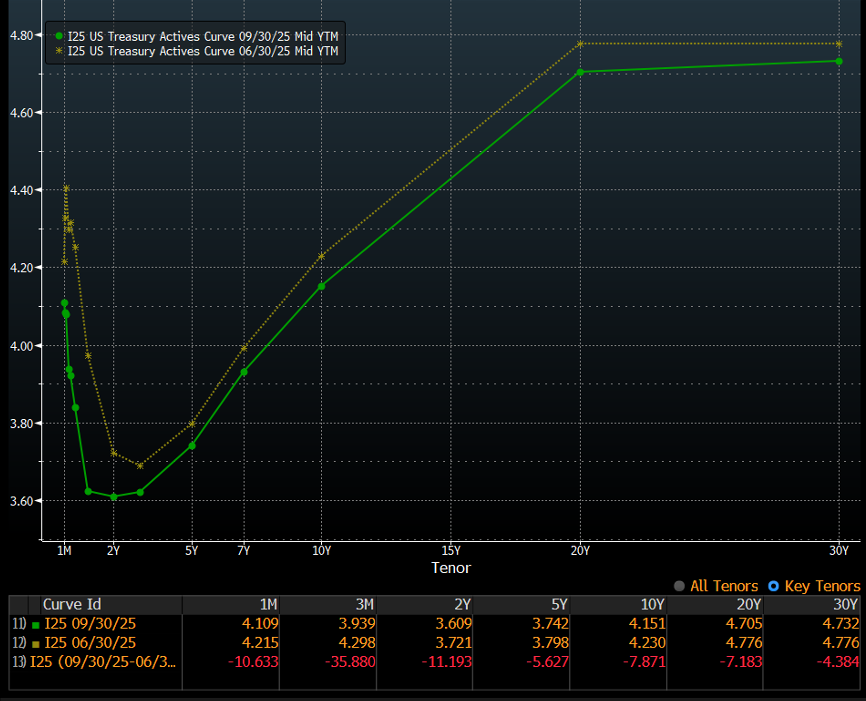
Inspire Investing, LLC serves as the investment adviser to certain proprietary ETFs used in Inspire portfolios. Inspire receives management fees from these ETFs, creating a potential conflict of interest. Inspire seeks to mitigate this conflict through policies and procedures that ensure recommendations are made in clients' best interests and consistent with their unique goals and risk profiles. Additional details can be found in Inspire's Form ADV Part 2A. Past performance is not indicative of future results. All performance figures referenced herein are historical and may not reflect current or future market conditions. Actual investor outcomes may vary. There is no assurance that any investment strategy will achieve its objectives or avoid losses.
The Fed restarted its process of lowering interest rates after remaining on pause for the past 5 FOMC meetings; however, core inflation remains elevated at 3.1%, well above the Fed’s target of 2.0%. We will likely see more interest rate decreases in the final two FOMC meetings in 2025 and into the first part of 2026.
The yield curve reversed its climb and fell in a parallel fashion due to the interest rate cut during the most recent FOMC meeting. Employment numbers showed weakness, but a recession is probably not on the immediate horizon this year, so we probably need to expect lower interest rates in the next few months. Total job openings continue to tick down, and Private (ADP) employment gains are slowing as well, but Consumer Sentiment, measured by the University of Michigan Consumer Sentiment Index, has steadily been falling since hitting resistance at 61.8 in July and is now at 55.1 as of the third quarter. It is believed that in the third quarter, GDP will be at or below 2% annualized growth, as a few analysts believe that the strong GDP numbers in Q2 will not be able to be sustained.
The global capital markets continue to face several geopolitical risks as we move into the fourth quarter of 2025, which could significantly impact investor sentiment and market stability. One key concern is government shutdown and political divide in Washington. There are also new tariff threats on India and China, as well as threatened sanctions on Russia due to the ongoing war in Russia and Ukraine, even though the Trump administration is still trying to get both sides to the table to negotiate a lasting peace. We believe that volatility in stock prices will remain high and may be driven by new issues that we haven’t considered yet. As usual, we will closely monitor global and domestic developments and assess their potential impacts on our investment strategies.
Certain statements may include forward-looking information based on current beliefs, expectations, and assumptions. These statements are not guarantees of future performance and involve known and unknown risks, uncertainties, and other factors that may cause actual results to differ materially. Inspire undertakes no obligation to update or revise any forward-looking statements.
We believe that we are still in the early innings of the bull market, as the markets continued the upward path with positive performance this quarter for all our ETFs. We were also pleased to see a few of our ETFs outperforming their secular benchmark. With the strong market performance over the past 5 months, we would not be surprised to see a correction of -10% or more in the next 3 to 6 months as investors look to take profits or rebalance their portfolios over the next couple of quarters. We still expect the broader large-cap market, as well as the small and mid-cap markets that have been ignored for most of the past two years, to show tremendous upside potential in the next 12 to 24 months. We will always face headwinds, but the market almost always ‘climbs a wall of worry’ so we need to remain patient and stay focused on long-term opportunities.
Whatever may come, our Lord is still in control. We remain thankful for the provision, protection, and blessings that we receive from our Heavenly Father and are looking expectantly to what God has in store for the rest of 2025 and beyond.
We are thankful for each of you for bringing Glory and Honor to our Heavenly Father and our Savior Jesus Christ as you serve your clients through Biblically Responsible Investing.
Inspire Investing, LLC serves as the investment adviser to the Inspire ETFs mentioned in this document. As such, Inspire receives management fees from these funds. This creates a conflict of interest as the firm has a financial incentive to promote its proprietary funds. Inspire seeks to mitigate this conflict through disclosure and a fiduciary duty to recommend investments suitable for clients.
Certain statements contained in this document may be forward-looking in nature and based on current expectations, estimates, and projections. Such statements are not guarantees of future performance and involve risks and uncertainties that are difficult to predict. Actual outcomes may differ materially.
This content is provided for educational and informational purposes only and should not be considered personalized investment advice. Inspire does not provide legal, tax, or accounting advice. Please consult your own advisor regarding your specific situation.


Prepared by Darrell W. Jayroe, CFA, CFP®, CKA®
SENIOR PORTFOLIO MANAGER
for financial professional use only - not for use with the general public